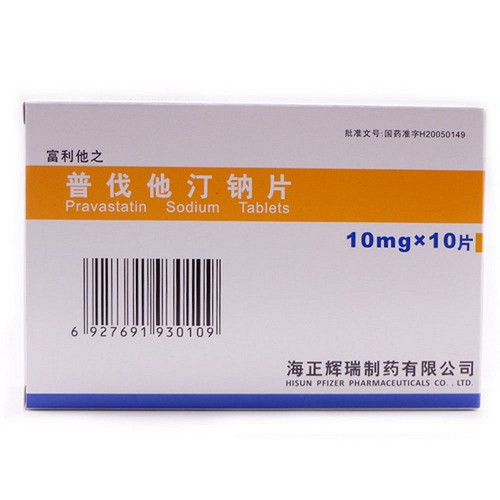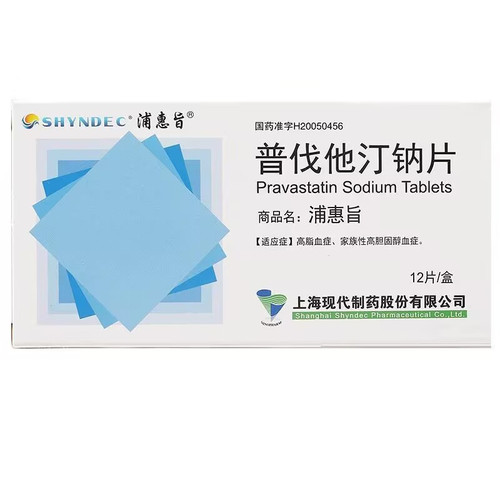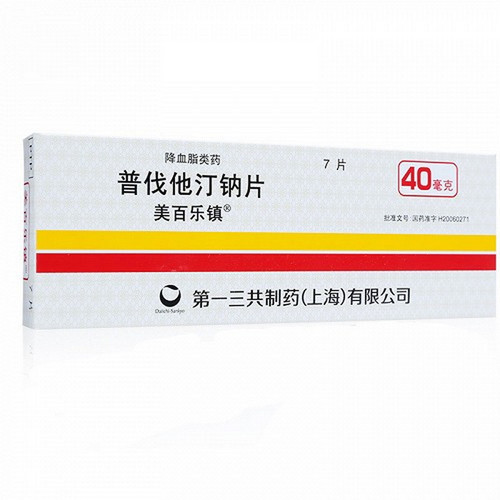Product Overview
[Drug Name]
Generic Name: Pravastatin Sodium Tablets
Trade Name: Fulitazhi Pravastatin Sodium Tablets 20mg x 10 Tablets
[Main Ingredient]
Pravastatin Sodium
[Properties]
This product is white or off-white tablets.
[Indications/Main Functions]
Indicated for primary hypercholesterolemia types IIIa and Ib that cannot be controlled with dietary restrictions.
[Specifications]
20mg x 10 tablets (Fulitazhi)
[Dosage and Administration]
Oral. The starting dose for adults is 10mg-20mg once daily, taken at bedtime. The maximum daily dose is 40mg.
[Adverse Reactions]
Adverse reactions with this product are mild and transient. Discontinuation of treatment due to adverse reactions is uncommon. They are generally asymptomatic elevations in serum transaminases and mild nonspecific gastrointestinal discomfort. Other common adverse events include: Cardiovascular: chest pain, angina pectoris. Skin: rash. Gastrointestinal: Nausea, vomiting, diarrhea, abdominal pain, constipation, flatulence, heartburn, dyspepsia. Musculoskeletal: Local pain, myalgia, bone pain (including arthralgia). Nervous: Headache, dizziness, insomnia, depression, anxiety/tension. Renal/urinary: Abnormal urination (dysuria, frequent urination, nocturia). Respiratory: Cold, rhinitis, cough, dyspnea. Special senses: Visual disturbances (including blurred vision, diplopia). Other: Fatigue. In long-term clinical studies, adverse events probably, possibly, or uncertainly related to pravastatin with an incidence of <1.0% included: Skin: pruritus, dermatitis, dry skin, scalp and hair abnormalities (including alopecia), urticaria. Endocrine/metabolic: Sexual dysfunction, altered libido. Gastrointestinal: Decreased appetite. General: Fever, flushing. Immune: Allergic reaction, head and neck edema. Muscle and skeletal: Myopathy, rhabdomyolysis. Nervous System: Paresthesia, vertigo, insomnia, memory impairment, tremor, neuropathy (including peripheral neuropathy). Special Senses: Lens opacities, dysgeusia. Other rare adverse events of unknown drug relationship include: Musculoskeletal: Myopathy, rhabdomyolysis. Nervous System: Dysfunction of some cranial nerves (including taste changes, extraocular muscle movement disorders, facial palsy), peripheral nerve palsy. Allergy: Anaphylaxis, lupus erythematosus-like syndrome, polymyalgia, rheumatism, dermatomyositis, nodular vasculitis, purpura, hemolytic anemia with positive antinuclear antibodies, increased erythrocyte sedimentation rate, arthritis, arthralgia, weakness, photosensitivity, chills, malaise, toxic epidermal necrolysis, erythema multiforme, including Stevens-Johnson syndrome. Gastrointestinal: Pancreatitis, hepatitis, including chronic active hepatitis, cholestatic jaundice, fatty liver, cirrhosis, fulminant hepatic necrosis, hepatoma. Skin Diseases: Various skin changes (e.g., nodules, hyperpigmentation, mucosal dryness, hair and nail changes). Reproductive: Gynecomastia. Laboratory Abnormalities: Elevated serum transaminases (ALT, AST), elevated creatine phosphokinase (CPK), asymptomatic eosinophilia, and rarely elevated blood urea nitrogen (BUN) and serum creatinine. In addition, HMG-CoA reductase inhibitors have been reported to cause anemia, thrombocytopenia, and leukopenia.
[Contraindications]
This product is contraindicated in patients with allergies, active hepatitis or persistently elevated liver function tests, and in pregnant or lactating women.
[Drug Interactions]
1. Concomitant use of immunosuppressants such as erythromycin and cyclosporine, niacin, and fibrates increases the potential for myopathy caused by other HMG-CoA reductase inhibitors. Although no adverse event differences were observed in trials of pravastatin combined with probucol or gemfibrozil compared to pravastatin alone, no increase in LDL-lowering efficacy was observed. Because myopathy and rhabdomyolysis (with or without acute renal failure) have been reported following coadministration of HMG-CoA reductase inhibitors with immunosuppressants, gemfibrozil, erythromycin, and lipid-lowering doses of niacin, coadministration of HMG-CoA reductase inhibitors with these drugs is not recommended. 2. In vitro and in vivo data from cytochrome P450 3A4 inhibitors indicate that pravastatin is metabolized by cytochrome P450 3A4 to a very low degree and of no clinical significance. Cytochrome P450 3A4 inhibitors include diltiazem, itraconazole, ketoconazole, the calcium channel blocker mirapidil, and erythromycin. 3. Diltiazem Known cytochrome P450 inhibitors have no effect on the pharmacokinetics of pravastatin during the period when blood concentrations reach steady-state. However, studies have shown that diltiazem can increase the UC and Cmax of another HMG-CoA reductase inhibitor metabolized by cytochrome P450 3A4 by 3.6- and 4.3-fold, respectively. 4. Itraconazole: Itraconazole is a known potent cytochrome P450 3A4 inhibitor that inhibits the P-glycoprotein transporter. 1. Itraconazole can increase the mean AUC and Cmax of pravastatin by 1.7- and 2.5-fold, respectively. The mean half-life (t1/2) of pravastatin was not affected by itraconazole. Since itraconazole is transported by P-glycoprotein, this result suggests that the slight increase in pravastatin's AUC and Cmax is primarily due to increased bioavailability rather than decreased clearance. The P-glycoprotein transporter affects the bioavailability and excretion of HMG-CoA reductase inhibitors, including pravastatin. Another HMG-CoA reductase inhibitor known to be metabolized by cytochrome P450 3A4 increased its AUC and Cmax by 19- and 17-fold, respectively, when coadministered with itraconazole. 5. The concomitant administration of pravastatin with antipyrine had no effect on its clearance. Based on this, there is no interaction between pravastatin and other drugs metabolized by the same hepatic cytochrome P450 enzyme. 6. Cholestyramine/Coletipol: This product can enhance the lowering of total cholesterol and LDL-C when used in combination with bile acid binding resins (e.g., cholestyramine and colestipol). (Note: Concomitant use of pravastatin with such drugs can reduce the average AUC of pravastatin by approximately 40% to 50%. Therefore, pravastatin should be taken one hour before or four hours after cholestyramine and one hour before colestipol and meals.) 7. Warfarin: Concomitant use of warfarin and 40 mg of pravastatin has no effect on the prothrombin time. 8. Cimetidine: The 0-12 hour AUC of pravastatin alone and the 0-12 hour AUC of pravastatin combined with cimetidine are similar. There was no difference in the AUC of pravastatin alone or in combination with cimetidine, and the AUC of pravastatin when combined with antacids was different. In a crossover study of 18 healthy men, digoxin bioavailability remained unchanged after 9 days of coadministration of 0.2 mg digoxin and 20 mg pravastatin. There was a significant difference in the AUC of pravastatin. There was a trend toward an increase in the AUC, but the combined bioavailability of pravastatin and its metabolites, SQ31,906 and SQ131,945, was unchanged. 10. Cyclosporine: To date, some studies have used cyclosporine in combination with pravastatin (at doses up to 20 mg). Clinical data on cyclosporine do not show that the drug concentration of cyclosporine is affected by pravastatin. In a single-dose study, it was found that organ transplant patients taking cyclosporine increased the blood concentration of pravastatin. Therefore, patients taking cyclosporine and pravastatin at the same time should pay attention to the starting dose of pravastatin of 10 mg, taken before bedtime every day, and carefully increase to a higher dose step by step. For most patients taking this combination drug, the maximum dose of pravastatin is 20 mg per day. 11. Gemfibrozil: Clinical trials have found that when pravastatin is used in combination with gemfibrozil, CPK levels are increased and musculoskeletal symptoms lead to drug discontinuation. The rate showed an upward trend compared with the placebo control group, the gemfibrozil group, and the pravastatin group. The urinary excretion of pravastatin and its protein binding were reduced. At the same time, the AUC and Cma× values of the pravastatin metabolite SQ31,906 were significantly increased, and Tmax was prolonged. It is recommended that pravastatin should not be used in combination with gemfibrozil. 12 There was no significant difference in the pharmacokinetics of pravastatin when used in combination with aspirin, antacids (1 hour after taking this product), cimetidine, and niacin. There was no significant difference in the pharmacokinetics of pravastatin when used in combination with diuretics, antihypertensive drugs, digitalis, angiotensin-converting enzyme inhibitors, calcium channel blockers, receptor blockers, or nitroglycerin. Interactions.
[Precautions]
1. Similar to other HMG-CoA reductase inhibitors, this product may increase alkaline phosphatase and transaminase levels. It is recommended that liver function tests be performed before treatment, before dose adjustments, or when necessary. Pravastatin is contraindicated in patients with active liver disease or unexplained persistent transaminase elevations. Pravastatin should be used with caution in patients with a recent history of liver disease, those with liver disease (e.g., unexplained persistent transaminase elevations, jaundice), or those who are alcoholics. For these patients, it is advisable to start with the minimum recommended dose and gradually adjust to an effective therapeutic dose with close observation. During treatment, if the patient develops elevated transaminases or symptoms or signs of liver disease, liver function tests should be repeated until liver function returns to normal. If AST or ALT continues to exceed the upper limit of normal by three times or more, pravastatin should be discontinued. 2 Pravastatin and other similar drugs rarely cause rhabdomyolysis and acute renal failure secondary to myoglobinuria. Pravastatin can cause uncomplicated myalgia. Myopathy manifests as muscle tenderness or muscle weakness near the joints, and creatine phosphokinase (CPK) is elevated by more than 10 times the upper limit of normal. Patients with diffuse myalgia, muscle tenderness or muscle weakness, and/or significantly elevated CPK Consider the possibility of myopathy. Report muscle pain, tenderness, or weakness, especially if accompanied by fatigue or fever, to a physician immediately. If CPK is significantly elevated, myopathy is suspected or confirmed, discontinue pravastatin. Suspend pravastatin if the patient experiences acute or severe conditions that could lead to acute renal failure secondary to rhabdomyolysis, such as sepsis, hypotension, major surgery, trauma; severe metabolic and secretory disorders, electrolyte imbalances; or uncontrolled epilepsy. 3. Concomitant use of erythrotoxin, cyclosporine, niacin, and fibrates may increase the risk of other HMG-COA reduction inhibitors. Possibility of myopathy. Clinical trials have found that the incidence of increased CPK levels and discontinuation of drug treatment due to skeletal muscle symptoms in patients in the combination drug treatment group tended to be higher than those in the placebo control group and the gemfibrozil and pravastatin groups. Myopathy occasionally occurs with fibrate therapy alone. Unless the benefits of the lipid-lowering effect of the combined drug significantly outweigh their harms, pravastatin should generally not be used in combination with fibrates. 4. Patients with homozygous familial hypercholesterolemia: The effect of this product has not been determined. There are reports that this type of patient has a poorer efficacy due to the lack of LDL receptors. 5. Patients with poor renal function should take 20ml of this product orally daily. g, although no obvious pharmacokinetic changes were observed, there was a slight increase in AUC and half-life. Patients with impaired renal function should be closely observed if they take this dose. 6. Endocrine function: HMG-CoA reductase inhibitors interfere with the synthesis of cholesterol and reduce the concentration of cholesterol in the blood, which may theoretically affect the synthesis of adrenal glands and steroid hormones. Clinical trials showed different results for the effects of this product on the synthesis of steroid hormones in men and menopausal women. In a trial involving 21 men, after 16 weeks of treatment with 40 mg of this product, the response of testosterone to chorionic gonadotropin decreased significantly (p < 0.004. Then ≥ 50 In some patients, testosterone levels did not decrease. There is insufficient research data on the effects on spermatogenesis and fertility. Patients with endocrine dysfunction should be appropriately evaluated after using this drug, and particular caution is advised when using it in combination with other medications that may lower steroid hormone levels.
[Pediatric Use]
Although studies have evaluated the efficacy and safety of this drug at a daily dose of 40 mg in children and adolescents aged 8-18 years abroad, no data are available in Chinese patients under the age of 18. Therefore, its use is not currently recommended for patients under the age of 18.
[Elderly Use]
The average AUC of oral pravastatin in elderly patients is significantly lower than that in healthy young adults. Pravastatin has a slightly higher Cmax, Tmax, and half-life than pravastatin alone (25-50%), but the mean Cmax, Tmax, and half-life were similar between the two groups. No significant accumulation of pravastatin has been observed in the elderly.
[Overdose]
To date, no overt clinical symptoms or clinical laboratory abnormalities have been reported in reports of pravastatin sodium overdose. If an overdose occurs, systemic treatment should be initiated, and supportive monitoring procedures should be established as required. The maximum recommended dose should not be exceeded.
[Pharmacology and Toxicology]
Pharmacological Action: This product is a competitive inhibitor of 3-hydroxy-3-methylglutaryl coenzyme A (HMG-COA) reductase. HMG-COA also HMG-CoA reductase is the rate-limiting enzyme that catalyzes the conversion of HMG-CoA into mevalonate in the early stages of cholesterol biosynthesis. This product reversibly inhibits HMG-CoA reductase, thereby inhibiting cholesterol biosynthesis. This product exerts its lipid-lowering effect in two ways. First, it reversibly inhibits the activity of HMG-CoA reductase to reduce the amount of cholesterol in cells to a certain extent, leading to an increase in the number of low-density lipoprotein (LDL) receptors on the cell surface, thereby enhancing the receptor-mediated catabolism of LDLC and the clearance of LDL-C in the blood. Second, it inhibits the production of LDL-C precursor - very low-density lipoprotein (VLDL-C) in the liver. It inhibits LDL-C production by inhibiting its synthesis in the heart. Studies have shown that elevated total cholesterol, low-density lipoprotein cholesterol (LDL-C), and apolipoprotein B (ApoB) can contribute to the development of atherosclerosis in the human body. Similarly, lowering the levels of high-density lipoprotein cholesterol (HDL-C) and its transport complex, apolipoprotein A (ApOA), is also associated with the development of atherosclerosis. Cardiovascular morbidity and mortality rates increase with elevated total cholesterol levels and decrease with elevated HDL levels. Although elevated triglyceride levels are often associated with low HDL levels, they cannot be considered an independent risk factor for coronary heart disease. There is no definitive conclusion on the effect of simply increasing HDL or lowering triglycerides on the incidence or mortality of coronary artery disease and cardiovascular disease. In healthy volunteers and patients with hypercholesterolemia, treatment with this product can reduce total cholesterol, LDL and apolipoprotein B, and reduce VLDL and triglycerides, while increasing HDL and ApoA. The effect on other independent risk factors of coronary heart disease such as Lp(a) and fibrinogen is still unclear. Clinical studies have shown that this product can reduce the incidence and mortality of cardiovascular disease in patients with varying degrees of elevated cholesterol. Pravastatin is hydrophilic. This property is closely related to its efficacy and safety. The relationship between pravastatin and leukemia is unclear. Toxicological effects: Pravastatin 25 mg/kg/day can cause central nervous system vascular damage in dogs, manifested as perivascular hemorrhage and edema, and infiltration of mononuclear cells in the perivascular space. Calculated by AUC, this is 59 times the dose of 80 mg/day in humans. Similar drugs can also cause similar central nervous system vascular damage. Another similar drug can cause optic nerve degeneration (Walera geniculate retinal fibrosis) in normal dogs. This effect is dose-dependent, with the lowest dose being 60 mg/kg/day, which is equivalent to 30 times the maximum recommended dose for humans based on its enzyme inhibitory activity. 180mg/kg/day for 14 weeks can cause Walleian degeneration of the vestibulocochlear walleans and chromatin dissolution of retinal ganglion cells in dogs. The dose that causes the reaction is 60m9/9/day, calculated based on the average plasma concentration. Rats were given pravastatin 10, 30 and 10mg daily orally for a long time. The incidence of hepatocellular carcinoma in male rats in the highest dose group was significantly increased (p<0.0101). The dose of drug used in rats that developed hepatocellular carcinoma was 12 times the highest recommended human dose of 80mg based on body surface area conversion; based on AUC conversion, it was 4 times the highest recommended human dose. Mice were given pravastatin 100, 250 and 500mg orally. mg/g/day, the incidence of hepatocellular carcinoma in female and male rats in the 250mg and 500mg groups was significantly increased (p<0.001). The incidence of lung adenoma in female animals in the 250mg and 500mg groups was significantly increased (p=0.013), and no drug-induced tumors were observed in the 100mg water g group. Based on AUC, oral administration of 100mg water g, 250mg/g and 500mg/g to mice was equivalent to 2, 15 and 23 times the daily dose of 80mg for humans, respectively. In vitro tests, including microbial reversion mutagenicity tests with mutant strains of Salmonella typhimurium and Escherichia coli, mouse lymphocyte L5178YTK+/forward gene mutation test, hamster infection No mutagenicity was observed in chromatographic aberration tests and Saccharomyces cerevisiae gene transfer assays, with or without rat liver metabolic activators. Furthermore, no mutagenicity was observed in the dominant lethality test or the mouse micronucleus test. Oral pravastatin at doses up to 500 mg/day in rats showed no adverse mutagenic effects related to fertility or reproduction. However, other studies of HMG-CoA reductase inhibitors have demonstrated decreased fertility and vas deferens degeneration characterized by necrosis and loss of the seminiferous epithelium in male rats at various dose levels, and drug-related testicular atrophy, decreased spermatogenesis, spermatocyte degeneration, and giant cell formation in dogs. The clinical significance of these findings is unclear.







